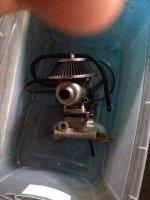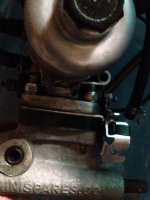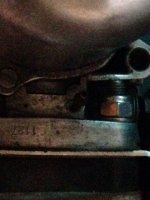AudreysDriver
Freshman Member
Offline
I have a '62 Sprite Mark II. She's named Audrey.
Back in the 70's she was set up for racing. Back in about 1993 I put an A+ (1300) engine in, and then I replaced the dual carbs with an HIF6 single carb. Then I had kids and put the car away for 15 years. Now we're getting it all going again. I'm following the books, but I have some questions that some experts might easily answer.
I see that Dan Lewis posted a similar question, but with quite a different carb. So I post this.
I've cleaned the carb. I haven't yet messed with the mixture screw. As far as I can see, the single HIF6 carb has only that one mixture screw.
I've gapped and static timed the distributor. I've adjusted the valves to 0.012" cold.
She starts pretty easily with the choke pulled out. But even warmed up, I can't get an even idle down to below about 1500 RPM. If I push the choke in farther, she stalls. Even when she's warmed up, I can't push the choke in all the way. Then when I step on the gas, the RPM drops like the engine will stall. If I baby the accelerator she'll run well at high RPM.
Does this sound like a familiar problem to anyone?
One thing that bothers me: The distributor on my A+ engine has a vacuum advance port, but there is no vacuum takeoff on the carb or manifold. I understand that this means I don't get any advance at idle. Could this account for what I see? Or does this sound like something that carb tuning can help? Or does it sound like something else wrong? If I'm going to install a vacuum port, where should I put it? I don't see any removable plugs on the carb. I was considering drilling into the spacer between the carb and the manifold. That seems like bakelite, so I hesitate to drill it. But the post about the weber implies quite different behavior with a vacuum port on the manifold rather than the carb.
When all of this was new, it worked better than now. The engine's got about 10000 miles on it, the carb has less.
Back in the 70's she was set up for racing. Back in about 1993 I put an A+ (1300) engine in, and then I replaced the dual carbs with an HIF6 single carb. Then I had kids and put the car away for 15 years. Now we're getting it all going again. I'm following the books, but I have some questions that some experts might easily answer.
I see that Dan Lewis posted a similar question, but with quite a different carb. So I post this.
I've cleaned the carb. I haven't yet messed with the mixture screw. As far as I can see, the single HIF6 carb has only that one mixture screw.
I've gapped and static timed the distributor. I've adjusted the valves to 0.012" cold.
She starts pretty easily with the choke pulled out. But even warmed up, I can't get an even idle down to below about 1500 RPM. If I push the choke in farther, she stalls. Even when she's warmed up, I can't push the choke in all the way. Then when I step on the gas, the RPM drops like the engine will stall. If I baby the accelerator she'll run well at high RPM.
Does this sound like a familiar problem to anyone?
One thing that bothers me: The distributor on my A+ engine has a vacuum advance port, but there is no vacuum takeoff on the carb or manifold. I understand that this means I don't get any advance at idle. Could this account for what I see? Or does this sound like something that carb tuning can help? Or does it sound like something else wrong? If I'm going to install a vacuum port, where should I put it? I don't see any removable plugs on the carb. I was considering drilling into the spacer between the carb and the manifold. That seems like bakelite, so I hesitate to drill it. But the post about the weber implies quite different behavior with a vacuum port on the manifold rather than the carb.
When all of this was new, it worked better than now. The engine's got about 10000 miles on it, the carb has less.

 Hi Guest!
Hi Guest!

 smilie in place of the real @
smilie in place of the real @
 Pretty Please - add it to our Events forum(s) and add to the calendar! >>
Pretty Please - add it to our Events forum(s) and add to the calendar! >> 





